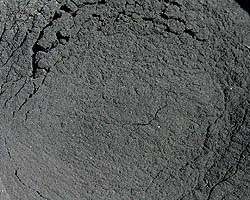Copper (II) oxide
From PyroGuide
Formula: CuO
Synonyms: Cupric oxide, black copper oxide
Description: Copper oxide is a black powder employed in blue color compositions in combination with chlorine donors. It is also used in high temperature thermite mixtures. (like crackling microstars) Cupric oxide is used in the ceramic industry for imparting blue, green or red tints in glasses, glazes and enamels. It is occasionally employed for incorporation in mineral supplements for insuring against an insufficiency of copper in the diet of animals. Among its other uses is the preparation of copper ammonium hydroxide solutions for the rayon industry.
Hazards: Copper(II)oxide is harmful and should be handled wearing a dust mask.Copper(II) oxide is an irritant. It also can cause damage to the endocrine and central nervous system. Contact to the eyes can cause irritation and damage to the corneas, and potentially can cause conjunctivitis. Contact to the skin can cause irritation and discoloration. Ingesting cupric oxide can lead to central nervous system depression, liver and kidney damage, gastrointestinal damage, circulatory system failure or damage to the vascular system. Inhalation can lead to damage to the lungs and septum. Inhalation of fumes of cupric oxide can lead to a disease called metal-fume fever, which has symptoms similar to influenza. Prolonged exposure to cupric oxide can lead to dermatitis, and can cause a toxic build-up of copper in people with Wilson's disease. Handling copper(II) oxide should be done in well ventilated area, and care should be taken to avoid contact with the skin or eyes. After handling, one should wash thoroughly.[1]
Sources: Copper(II)oxide is usually available from ceramic supply stores.
Synthesis: Method 1: Add a solution of sodium or potassium hydroxide to a hot solution of a soluble copper(II) compound (Copper sulfate or Copper (II) chloride for example). This will yield a blue gel-like precipitate of Copper hydroxide. Then bring the solution to a boil. The precipitate will turn black and powdery. Boil for a minute or two to complete the reaction and allow the black copper (II) oxide precipitate to settle. Then decant the liquid. Add some boiling hot water to the precipitate, stir and allow to settle again. Then decant and repeat 5 more times. This will remove all soluble impurities from the copper(II)oxide. Then the precipitate is filtered and allowed to dry.
Method 2: Electrolysis of a oxidizing solution like chlorate solution yield copper (II) oxide as long as enough chlorate is present. The chlorate, sadly, convert back to chloride in this process. The result salt can be decanted and washed 3-4 times for purity. Other oxidizing soluble salts like bleach (Sodium hypochlorite) can be used. Once the oxidizing substance is depleted, the electrolysis will form Copper (I) oxide (Cu2O) which can be turned into Copper (II) oxide by roasting it in air.
Method 3: Heat dry Copper hydroxide to 185oC, wet Copper hydroxide to 80oC, or Copper carbonate (basic) to 290oC.
[edit] References
http://www.wfvisser.dds.nl/EN/cheminfo_EN.html
Images from http://www.keten.org.pl used with permission. Thanks a lot!
CopperColors blog [1]
Wikipedia [2]

